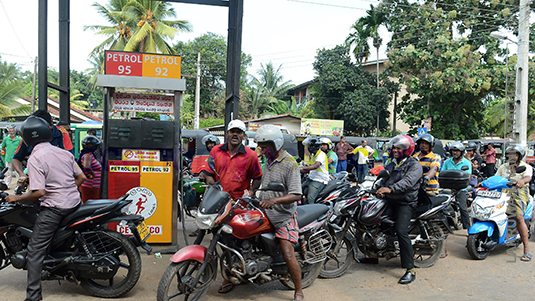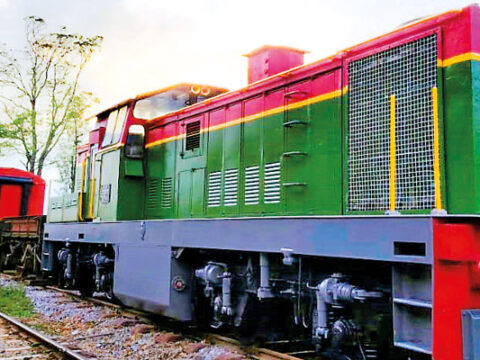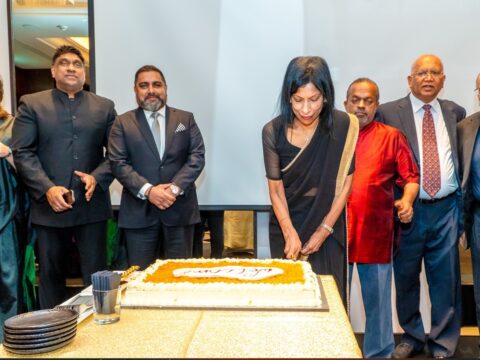COLOMBO: Galle Face is Colombo’s showpiece sea front. China and India have cheek-by-jowl real estate here. The Taj Samudra is an old property, dwarfed by the towering Shangri-La of the Hong Kong chain of hotels. And next to it, India’s Larsen & Toubro is constructing an ITC hotel. Out in the water is the Chinese Port City project, coming up rapidly on reclaimed land.
Nearly seven decades ago, the Federal Party representing the country’s Tamils held a one-day satyagraha on the green next to the sea, opposite what was then the parliament building. It was a peaceful protest against the Sri Lankan government’s ‘Sinhala Only’ legislation that took away the official language status of Tamil. But the demonstration was broken up as mobs armed with sticks attacked the protesters, cracking skulls as the police looked away. The rest is history.
That same site is now the centre of another peaceful protest. Thousands of mostly young Sri Lankans have gathered here daily since April 9 demanding that President Gotabaya Rajapaksa and other family members in office, including his brother Prime Minister Mahinda Rajapaksa, step down. The old parliament building now functions as the presidential secretariat.
On a patch of green between President Rajapaksa’s office and a soaring statue of S W R D Bandaranaike, the prime minister whose controversial language policy had brought Tamils out on the streets seven decades ago, a tent city of protesters has sprung up. Called ‘Gota Go Gama’ — named after the angry “Go Gota Go” slogan resounding on the street these days — this symbolic village of resistance has come up against the Rajapaksa regime. Hundreds of people have been camping at the site, with the numbers swelling in the daytime.
The protests began in March as small candlelight vigils at traffic junctions in Colombo. The demonstrators were protesting long power cuts imposed by the government because it did not have enough dollars to buy the diesel needed to run the power plants.

Since the middle of last year, essential items have been in short supply as imports have been restricted and prices have skyrocketed. With supplies dwindling, shops have had to restrict purchases and even those with money found themselves shut out. Queues stretch outside fuel stations and government-run fair price shops, with people waiting three to four hours to fill their vehicles or plastic cans. Double lines of cars wait for petrol, withpeople discussing if it is better to return for a refill at quarter tank or empty.
The protests have grown, bringing out students, teachers, lawyers, doctors, nurses and other professionals and
youth. The government has so far not cracked down.
Unarmed police regulate the traffic around the area which leads to Colombo’s main business district. Vehicles honk in solidarity with the protesters as they pass through.
What next? Beyond their assertion that the Rajapaksas must go, not many at the protest site know what the future holds in store for them and their country.
“I know they are not going to resign just because we are asking them to go. But the pressure of the people is important. Our voices will be heard in Parliament and Parliament has to make its decisions based on that,” says 43-year-old Rebecca David, a rights activist who has been at the Galle Face protests from the start.

The government had declared a full-week holiday for the Sinhala and Tamil New Year on April 14, hoping people would stay indoors.But that had the opposite effect: New Year’s Day saw the maximum turnout at Galle Face, with the atmosphere festive and carnival-like.
“Now it looks like people won’t give up till they get a result. They want to see the President step down,” says David. “They want to see change.”
March 31 was a turning point for the Rajapaksas. That day, hundreds of people protesting the shortages marched to the President’s private home in the Colombo suburb of Mirihana Pangiriwatta. Many of them were middle-class residents of the area and were shouting slogans seeking the President’s resignation. “Prosperity for rulers while hardship for people” was one slogan. They attempted to break through the barricades and clashed with police, who had to use water cannons and tear gas. Police vehicles were torched.
Until then, President Rajapaksa believed that as the architect of the military victory against the LTTE, he and his brothers had earned enough goodwill from the people to see them through the crisis.
The protests had actually begun much earlier in the countryside, as farmers shouted themselves hoarse against the overnight switch to organic farming and the ban on chemical fertilisers — measures taken to save precious foreign exchange. But until the protests reached Colombo, the Rajapaksas were sanguine. But that day of violence outside his house served as a reality check for President Rajapaksa. He is now said to be sequestered in his high-security official residence in the Fort area of Colombo, while his elder brother, the Prime Minister, is in his official residence at Temple Trees.
A day after the incident, on April 1, the President imposed an emergency and the police imposed a curfew in the capital, its suburbs and several outlying areas. In defiance of the curfew, protesters marched through the streets, daring the police to arrest them. By April 5, both curfew and emergency had to be withdrawn. On the same day, the government appeared to have lost its majority. A group of 42 parliamentarians belonging to the Sri Lanka Freedom Party, an alliance partner of the Rajapaksas’ Sri Lanka Podujana Party, said they had withdrawn from the coalition. But for those who believed this was a “regime change” moment for Sri Lanka, there was disappointment.
No challengers have emerged from the Opposition to overturn Prime Minister Rajapaksa. President Rajapaksa, who got all his cabinet ministers to resign — Prime Minister Rajapaksa remained in office — invited all Opposition parties and groups to form a national government to deal with the crisis. There were no takers for this either.
Meanwhile, the Rajapaksas are only too aware that there are few protests outside Colombo and its suburbs, and that if they wait it out, the weary protesters may head back home. The protesters know that too — that every moment of delay caused by the political impasse will only serve to strengthen the Rajapaksas’ resolve to cling on.
There is also suspicion that India’s $2.4 bn financial assistance, while bringing much needed food and fuel to the country, is helping the Rajapaksas.
Most analysts trace the economic crisis to ill-advised tax cuts that President Gotabya Rajapaksa ordered after his 2019 election. The cuts came into effect just before the pandemic, at a time when the 2019 Easter bombings had already gutted the tourism industry.
But some economists believe the problem began much earlier, in the years after the war ended in 2009. Armed with an IMF bailout, Mahinda Rajapaksa, then president, went on a borrowing spree for non-paying infrastructure projects.
As Sri Lanka now prepares for tough negotiations with the International Monetary Fund (IMF), Ahilan Kadirgamar, who teaches economics at Jaffna University, warns that those already crushed by the pandemic and the economic failures of the government would be the most affected by the conditions that the international lending agency is bound to
impose.
“The people who have come out on the streets today due to economic hardships are affected by cuts to social welfare and public services. Working people are going to be most affected as IMF conditions lead to austerity measures and market pricing of goods and services,” predicts Kadirgamar.
One noticeable aspect of the street protests is the secular language of the participants. If there is one refrain other than Go Gota Go, it is this: “The Rajapaksas divided Sri Lankans by race, language and religion. We will never allow anyone to do that again”.
Tamils and Muslims, two of Sri Lanka’s minorities that have long suffered othering by the majority Sinhala-Buddhists, are today among the protesters.
Jaffna parliamentarian M A Sumanthiran believes it is an important moment in Sri Lanka’s history of ethnic relations that the protesters are even taking up Tamil causes such as post-war justice and reconciliation, addressing war crimes, the repeal of the Prevention of Terrorism Act, among others.
However, the view from Jaffna is somewhat different. Here, there are no queues outside grocery shops or petrol pumps. However, fishermen, whose boats need diesel or kerosene, are among those hit by the shortages. At the Gurunagar jetty, fishermen have placed plastic cans in the queue, hoping supplies will arrive soon.
The times are tough, but the Tamils who have lived and survived the war years say they have known worse.
When the LTTE was in control of the peninsula, the government would send only limited quantities of petrol, diesel, kerosene and food rations by ship from Colombo, calculating that most people had fled, and the supplies would fall into the hands of the Tigers. There was no cooking gas either, as the government feared these would be used to make explosives. Ditto with batteries. Medicines were in short supply too.
After the bombing of Chunnakam power station, the peninsula, which used to get a total of one hour of power supply from this thermal plant when the war began between the Sri Lankan forces and the LTTE, lost all access to electricity. A generation of Jaffna students grew up studying with the help of kerosene lamps or dynamo-powered bicycle lights. Even after all these years since the war ended, homes still has a wood stove.
“In Colombo, they feel the shortages more because of the shortage of fuel, gas and power cuts. Here, we don’t feel it that much because we are used to this kind of scarcity,” says Rakesh Kannan, a general practitioner in Sydney, Australia, who is visiting his family in Jaffna.
At the Nallur Kandasamy temple, where he was offering prayers on Tamil New Year’s day, Kannan points at the parking lot, where two-wheelers and bicycles outnumber cars to say that petrol shortages were not a Jaffna problem.
He recalls the shortages from his time as a student, including when he was an undergrad student at the Jaffna teaching hospital: “I studied with a kerosene lamp.”
While Colombo has long been accused of neglecting Jaffna’s post-war economic development, in the present crisis, the war-torn Northern Province city appears to have been protected by its food self-sufficiency — farmers grow rice and vegetables — and a stoicism developed through its own war-time experiences. “People are saying very proudly that we didn’t die of a power cut then,” says Sumanthiran. Plus, Jaffna benefits from diaspora remittances, though not to the same extent as during the war.
Rajan Hoole, founder of the Jaffna University Teachers’ Human Rights that stood up against the violence and repression of the Tamil Tigers, says Sri Lanka is now “paying the price for the original sin of the 1948 Citizenship Act”, which rendered stateless and disenfranchised the Malayaha Tamils or Indian Origin Tamils (ethnically different from the Tamils of northern and eastern Sri Lanka) who worked in the tea plantations and who made up around 11 per cent of the population at the time.
“Until the mid-1960s, this 11 per cent was earning 65 percent of our foreign exchange. They were the mainstay of the free education and free health we enjoyed. Their shameful conditions, the neglect of their education and health and living conditions, raised the question if we were living in the real world,” Hoole said. “All that has caught up with us now”.
So far, there has been only one protest in Jaffna over the economic crisis. On social media, some in the Tamil community have mocked the Sinhalese outreach to minorities to join the “Sri Lankan” protests, asking why the majority community had displayed no such solidarity when the Tamils were suffering during the war years.
Despite this bitterness, says Sumanthiran, there is an acute awareness, especially among students, that this problem is as much a crisis for them as it is for the Sinhalese, that landless workers and the very poor among the Tamils would be hit the hardest.
Sumanthiran says the present crisis even offers an opportunity to address the Tamil question, through the abolition of the executive presidency, as some in the Opposition are demanding.
In many ways, it is ironic that the statue of SWRD Bandaranaike at Galle Face has become a beacon for the protesters. Google now throws up “Driving Directions” to the statue, with real-time information on how long it might take to reach the centre of the protests.
Bandaranaike, an Oxford-educated lawyer, was a founder-member of the Sri Lanka Freedom Party, and among the earliest to mine Sinhala-Buddhist majoritarianism for political advancement. His advocacy of “Sinhala Only” set the country down a path that the Rajapaksas, who were members of the same party until 2015, rounded off to their advantage six decades later, by claiming to have restored Sinhala pride with the defeat of the LTTE.
In the years since, a new generation has come of age. They may not know much about Sri Lanka’s failures of the past, but they are in the midst of a massive breakdown now, and sense that majoritarianism does not have the answers.
Standing near the towering Bandaranaike statue, D M Dissanayake, a lawyer in his 40s, says, “The Rajapaksas were heroes for winning the war against LTTE. After the Easter Sunday attacks, people thought the Rajapaksas are the sole protectors of the Sinhalese… They were swayed by triumphalism. Now people’s eyes have opened.”
© The Indian Express




